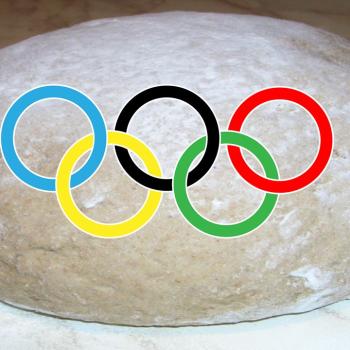This year, the Fall Equinox is September 22. Neopagans observe it as Mabon. Christians also observe Michaelmas and the Feast of St. Matthew the Apostle.

Breathe deeply this time of year, and you might just catch the scent of Autumn. Crisp morning air invites the mist to linger longer than it did in Summer’s heat. Borne on the fog, a hint of hearth fire reminds you of cozy days to come. But by midday the gloom has gone, shying away from the shining sun.
The Equinox
It’s the Equinox, when the Earth keeps one foot in Summer and the other in Fall. Day and night are of equal lengths. From here onward, it only gets darker until mid-winter. At this time, the year turns another corner, and we turn up our collars against the coming chill.
Balancing between Summer and Fall, Christians observe the Feasts of St. Matthew the Evangelist and St. Michael the Archangel. These days straddle the Neopagan holiday of Mabon. As the wheel of the year turns, it reminds Christians not to distance ourselves too far from our Pagan roots.
The Liturgical Calendar
Many Christian denominations observe a liturgical calendar. This begins with the season of Advent, which leads into Christmas and then Epiphany. From the stories of Jesus’ birth and infancy, the Church moves to narratives of his death and resurrection, with Lent, Holy Week, Easter, and Pentecost. The other half of the year is Ordinary Time.
The Wheel of the Year
In the same way, Neopagans follow a cycle, called the Wheel of the Year. In Christian & Pagan Holidays: Groundhogs, Candlemas & Imbolc, I write about this wheel:
Pre-Christian Celts divided the year into eight equal portions, called “The Wheel of the Year.” The quarters fall at the summer solstice (Litha, on or around June 21), the winter solstice (Yule, on or around December 21), spring equinox (Ostara, on or around March 21), and fall equinox (Mabon, on or around September 21). The cross-quarters lie at the midpoints in each season. The midpoint of spring is Beltane, on or around May 1. The middle of summer is Lughnasadh, on or around August 1. Halfway through fall is Samhain, on or around November 1. The midpoint of winter is Imbolc, on or around February 1. (These dates are inverted for those who celebrate in the southern hemisphere.) Each of these quarters and cross-quarters represents a different phase in the agricultural year and carries with it a spiritual significance.
When Roman Catholicism entered the unchurched lands of Western Europe, it Christianized the indigenous festivals to facilitate the conversion of Pagans. Ostara was renamed Easter. Beltane was transformed into May Day with its fertility pole. Litha corresponds to the Roman Catholic Solemnity of the Birth of John the Baptist. Lughnasadh, the festival of first harvest, became Lammas, or the Loaf Mass. Mabon, the feast of the second harvest, became the Feast of Matthew the Apostle. The Church turned Samhain into All Saints’ Day. We are more familiar with the day before—All Hallows Eve, or Halloween. Christmas eclipsed Yule to such an extent that many think they are synonymous. And finally, Candlemas replaced Imbolc.
While it’s true that Christians appropriated indigenous European holidays and practices, learning to share can be a beautiful thing. What can Christians and Pagans learn from one another?

St. Matthew
Matthew (also known as Levi) was a tax collector whom Jesus called as a disciple. Here’s the account of this event, as told in the Gospel of Matthew:
As Jesus was walking along, he saw a man called Matthew sitting at the tax-collection station, and he said to him, “Follow me.” And he got up and followed him.
And as he sat at dinner in the house, many tax collectors and sinners came and were sitting with Jesus and his disciples. When the Pharisees saw this, they said to his disciples, “Why does your teacher eat with tax collectors and sinners?” But when he heard this, he said, “Those who are well have no need of a physician, but those who are sick. Go and learn what this means, ‘I desire mercy, not sacrifice.’ For I have not come to call the righteous but sinners.”
Jesus’s selection of the outcast tax collector, whom the other disciples would have branded a traitor, demonstrates the mercy that Jesus wants for all people. Matthew overcame the stigma of his early years by becoming one of the four canonical evangelists. He carried the Good News, perhaps to Persia and/or Ethiopia. It is rumored that he died as a martyr, but there is no historical evidence surrounding his death. He is the patron saint of bankers, actors, accountants, and bookkeepers. The Roman Catholic Church celebrates his feast day on September 21.
Michaelmas
Historically, Michaelmas (September 29) is a more significant observance than the Feast of St. Matthew. This day honors more than one archangel. It is also known as the Feast of Saints Michael, Gabriel, and Raphael. Let’s take a brief look at each of these celestial beings.
· Michael
In Daniel 10, an angel appears to the prophet, who has been praying for divine assistance. The angel refers to Michael as “one of the chief princes” in the heavenly realms. Revelation 12 and Joshua 5 depict Michael as the leader of God’s armies. In Jude 1:9, Michael contends with the devil over the body of Moses. (Click here to read more about Michael.)
· Gabriel
If Michael is the prototypical warrior angel, Gabriel represents God’s divine messengers. In Daniel 8, the heavenly courier appears in human form to help the prophet understand a vision. Luke 1 has Gabriel announcing the conception of John the Baptizer. Luke 2 depicts Gabriel announcing the conception of Jesus. (Click here to read more about Gabriel.)
· Raphael
Of the multiple archangels, the Protestant canon only mentions Michael and Gabriel. The Book of Tobit, in the Roman Catholic Bible, mentions Raphael as a binder of demons and as a healer. According to New Advent, there are three additional archangels, from the book of Enoch. They are Uriel, Raguel, Sariel, and Jerahmeel. But these do not share the feast day of September 29.
Traditionally, Michaelmas was related to the Autumn Equinox. As such, it was a time for people to gather, feast, and engage in commerce. This gathering is why Fall is a popular time for elections in Western countries.
The Week of Matthew and Michaelmas
As the Feast of Saints Michael, Gabriel, and Raphael, Michaelmas celebrates the archangels who lead the heavenly host. This feast day recognizes the invisible heavenly realms beyond mortal ken. It calls to mind the words of Shakespeare, “There are more things in heaven and earth, Horatio, than are dreamt of in your philosophy” (Hamlet, 1.5. 165–66).” September 29 reminds us of ethereal planes, planting one foot in angelic territory.
September 21 places the other foot squarely on the ground of earth. Matthew reminds us of mundane things like going to work, filling out ledgers, and handling money. He is the saint of “nose to the grindstone” types of people. Matthew begins a time of reflection on the everyday. A week and a day later, we contemplate the heavenlies. You might say that the Week of Matthew and Michaelmas allows us to keep one foot on earth, and the other in heaven. This is a season of balance.
What, or Who, is Mabon?
Balance is important, as Matthew’s Feast and Michaelmas stand astride the Neopagan celebration of Mabon, the Autumnal Equinox. Days and nights find equilibrium. Temperatures have begun to moderate. Summer is gone, and winter is coming. But Fall holds wonders of its own.
Patheos columnist Sorita D’Este offers an article entitled, “Did Mabon Steal the Autumn Equinox?” De’Este recognizes that until the 1970s, Pagans simply called this holiday the Autumn Equinox. When Neopagan author Aiden Kelly dubbed the holiday by the name of the Welsh deity Mabon ap Modron. De’Este writes, “There is some evidence that Mabon may have been a different name for the god Maponus, as they were sometimes equated.” Maponus, in turn, shares much in common with the Roman sun god Apollo.
Other deities come into play as well. Mabon House reports:
“The Greek goddess Demeter is more closely associated with the Autumn harvest, as her grief over losing her daughter, Persephone, turned the earth from lush abundance to barren cold. These myths of loss and renewal are at the heart of Mabon, symbolizing the balance between light and dark, life and death, and the ongoing cycle of the seasons.”
So, when we call the holiday by its modern name of Mabon, we recognize a layer of otherworldly complexity.
Mabon Celebrations
Yet, despite its complicated divine history, many Neopagans celebrate the Autumn Equinox with down-to-earth traditions. Mabon is a time to adorn your home with fall colors and natural elements such as pumpkins, gourds, acorns, pinecones, and other harvest decorations. As a harvest celebration, it’s a time to feast with family and friends, enjoy a bonfire, or go for a hayride.
Related to the harvest, Mabon is a time to practice gratitude. For this reason, the holiday is often called Pagan Thanksgiving. Kerry Ward and Erica Smith suggest keeping a gratitude journal or giving to charity at this time of year. Dhruti Bhagat says that American Thanksgiving was originally celebrated on October 3, closer to Mabon and Michaelmas celebrations.
A Foot in Each World
Just as Matthew’s Feast and Michaelmas plant one foot on the earth and the other in heaven, Mabon celebrations remind us of balance. Theologically, Mabon is complex, drawing influences from multiple cultures and pantheons. But practically, Autumn Equinox celebrations are down to earth. This balance between celestial and terrestrial realms seems appropriate for a time when dark and light have reached equilibrium. Christian and Pagan holidays remind us to keep a foot in each world if we want to maintain stability.
Unfortunately, Christians and Neopagans historically have withdrawn from each other, like the feet of a person involuntarily doing the splits. To be fair, Christians started the whole thing by persecuting Pagans, burning them as witches, and promoting the Satanic Panic. The onus is on Christians to straighten up and pull those two feet together, so we can stand with stability.
We’ve got to realize that it’s good for Christians and Pagans to befriend each other. Whether we like it or not, the two faiths are connected by history and by blood. The Equinox is a time of balance, of realizing the need to have a foot in each world. By linking arms and standing together, we can find stability.
For related reading, check out my other articles:
- Is It Ok to Be Friends with People of Other Faiths?
- How Neo paganismHas Made Me a Better Christian
- World Religion Day: How Christians Can Honor Other Faiths














